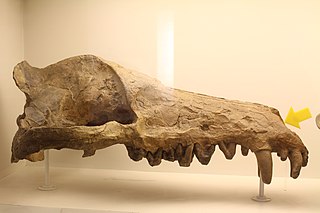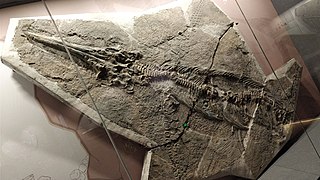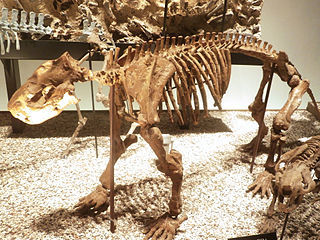
Andrewsarchus is an extinct genus of ungulate that lived during the Middle Eocene in China. It contains two species, A. mongoliensis and A. crassum. It was formerly placed in the families Mesonychidae or Arctocyonidae, but is now the sole member of a distinct family, Andrewsarchidae. Only known from a largely complete skull as well as isolated teeth, it is notable for being estimated as the largest terrestrial, carnivorous mammal, but that status has been disputed.
The Subashi Formation is a Late Cretaceous formation from the Xinjiang Autonomous Region of western China. Initially described by Dong Zhiming in 1977, the formation contains remains of Tarbosaurus which were initially described as a separate taxon Shanshanosaurus huoyanshanensis. Remains of a sauropod, likely Nemegtosaurus, and a hadrosaurid, likely Jaxartosaurus, have also been found.
Paleontology or palaeontology is the study of prehistoric life forms on Earth through the examination of plant and animal fossils. This includes the study of body fossils, tracks (ichnites), burrows, cast-off parts, fossilised feces (coprolites), palynomorphs and chemical residues. Because humans have encountered fossils for millennia, paleontology has a long history both before and after becoming formalized as a science. This article records significant discoveries and events related to paleontology that occurred or were published in the year 2000.

Miodentosaurus is a genus of thalattosaurian from the Late Triassic of China. It is one of several thalattosaurs found in the Xiaowa Formation, also known as the Wayao Member of the Falang Formation. The genus name "Miodentosaurus" translates to "Few toothed-lizard" while the species name "brevis" means "short", in reference to its short snout.

Tillodontia is an extinct suborder of eutherian mammals known from the Early Paleocene to Late Eocene of China, the Late Paleocene to Middle Eocene of North America where they display their maximum species diversity, the Middle Eocene of Pakistan, and the Early Eocene of Europe. Leaving no descendants, they are most closely related to the pantodonts, another extinct group. The tillodonts were medium- to large-sized animals that probably fed on roots and tubers in temperate to subtropical habitats.

Bishanopliosaurus is a genus of plesiosaur. The type species is B. youngi, based on remains found in the Ziliujing Formation of China.

Pteronisculus is an extinct genus of prehistoric ray-finned fish that lived during the Early Triassic and Middle Triassic epochs of the Triassic period worldwide.

Guizhouichthyosaurus is an extinct genus of ichthyosaur which is known primarily from the Xiaowa Formation of the lower Carnian stage of the Late Triassic in southwest China. The type species of this genus is Guizhouichthyosaurus tangae, of which multiple skeletons are known. It has been reassigned as a species of the genus Shastasaurus in the past, though it has since been considered distinct. The ichthyosaurs Cymbospondylus asiaticus, named in 2002, and Panjiangsaurus epicharis, named in 2003, are junior synonyms of G. tangae. The genus is also known from the Ladinian-aged Middle Triassic Zhuganpo Formation; additionally, the species "Callawayia" wollongangense may belong to Guizhouichthyosaurus.

Askeptosauridae is a family of thalattosaurs within the superfamily Askeptosauroidea. Fossils have been found from Italy, Switzerland, and China. Askeptosaurids are distinguished from other thalattosaurs by their long necks and narrow skulls.

Anshunsaurus is a genus of thalattosaurs within the family Askeptosauridae. Fossils have been found from Middle Triassic deposits in Guizhou, China. Three species are known: the type species A. huangguoshuensis, the slightly older species A. wushaensis, and the species A. huangnihensis.
Guanlingsaurus is an extinct genus of shastasaurid ichthyosaur from the Late Triassic of China. It grew up to 8.3 metres (27 ft) in length and has a wide, triangular skull with a short and toothless snout.
Diandongosaurus is an extinct genus of eosauropterygian known from the lower Middle Triassic of Yunnan Province, southwestern China. It is known from the holotype IVPP V 17761, a complete and articulated skeleton with skull, which was found in the middle Triassic Lagerstätte of the Guanling Formation. It was first named by Qing-Hua Shang, Xiao-Chun Wu, Chun Li in 2011 and the type species is Diandongosaurus acutidentatus. A referred specimen suggests a total body length of 34 cm (13 in).
Daqingshanodon is an extinct genus of dicynodont therapsid from the Late Permian of Inner Mongolia, China. The type species D. limbus was described in 1989 from a single skull found in the Naobaogou Formation. Daqingshanodon belongs to a group of dicynodonts called cryptodonts. It is the smallest known cryptodont, and the only one known from China. Like other cryptodonts, it has a pair of rounded nasal bosses above its nostrils and a ridge of bone on the upper jaw called the postcaniniform process. Daqingshanodon has a pair of elongated, recurved tusks extending from its beak-like snout. It is distinguished from other dicynodonts by the presence of a distinct ridge running along the side of the skull from below the eye socket to the area around the tusks. The skull of Daqingshanodon is less than 10 centimetres (3.9 in) long, yet this specimen is thought to have been an adult on the basis of its well-developed nasal bosses.

Sinophoneus is an extinct genus of carnivorous dinocephalian therapsid belonging to the family Anteosauridae. It lived 272 to 270 million years ago at the beginning of the Middle Permian in what is now the Gansu Province in northern China. It is known by a skull of an adult individual, as well as by many skulls of juvenile specimens. The latter were first considered as belonging to a different animal, named Stenocybus, before being reinterpreted as immature Sinophoneus. Sinophoneus shows a combination of characters present in other anteosaurs. Its bulbous profile snout and external nostrils located in front of the canine are reminiscent of the basal anteosaur Archaeosyodon, while its massive transverse pterygoids processes with enlarged distal ends are more similar to the more derived anteosaurs Anteosaurus and Titanophoneus. First phylogenetic analyzes identified Sinophoneus as the most basal Anteosaurinae. A more recent analysis positioned it outside the Anteosaurinae and Syodontinae subclades, and recovers it as the most basal Anteosauridae.
Ordosiodon is an extinct genus of therocephalian therapsids from the Early Triassic of China. It includes two species, O. lincheyuensis and O. youngi.
The Ermaying Formation is a geological formation of Anisian age in north-central China. It is found across much of the Ordos Basin, at outcrops within the provinces of Shaanxi, Shanxi, and Inner Mongolia. It is composed of up to 600 m thick sequence of mudstone and sandstone, overlying the Heshanggou Formation and underlying the Tongchuan Formation. In the southern part of the Ordos Basin, the Zhifang Formation is equivalent to the Ermaying Formation.
Taoheodon is an extinct genus of dicynodont therapsid from the Sunjiagou Formation in the Shanxi province of China, dated to the Wuchiapingian age of the Late Permian. Its type and only known species is T. baizhijuni. Taoheodon was a close relative of the well known Dicynodon, and may represent a biogeographical link between the South African Dicynodon and similar dicynodonts found in Laos.
The Zhuganpo Formation is a Triassic geologic unit found in southern China. It has historically been known as the Zhuganpo Member of the Falang Formation. A diverse fossil assemblage known as the Xingyi biota or Xingyi Fauna can be found in the upper part of the Zhuganpo Formation. Fossils of the Xingyi biota include articulated skeletons of marine reptiles, abundant fish, and a plentiful assortment of invertebrates indicating a Ladinian to Carnian age for the sediments of the formation.

The Liushu Formation is a geological formation in Gansu province, China that spans up to 100 m thick and is widely distributed within the Linxia Basin, with a paleomagnetic age between 11 and 6.4 mya.

Bemalambda is an extinct mammal, belonging to the pantodonts. It lived in the lower-middle Paleocene and the fossil remains have been found in China.
















